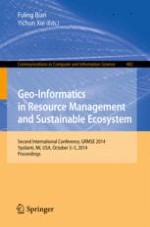This volume constitutes the refereed proceedings of the Second International Conference on Geo-Informatics in Resource Management and Sustainable Ecosystem, GRMSE 2014, held in Ypsilanti, MI, China, in December 2014. The 73 papers presented were carefully reviewed and selected from 296 submissions. The papers are divided into topical sections on smart city in resource management and sustainable ecosystem; spatial data acquisition through RS and GIS in resource management and sustainable ecosystem; ecological and environmental data processing and management; advanced geospatial model and analysis for understanding ecological and environmental process; applications of geo-informatics in resource management and sustainable ecosystem.
